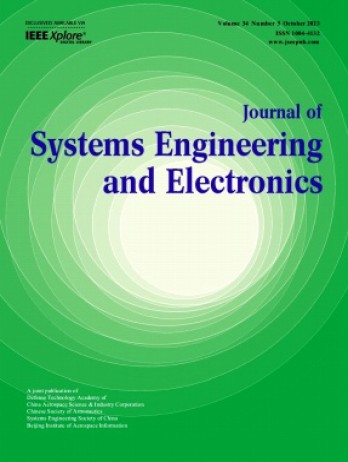
Journal of Systems Engineering and Electronics雜志簡介
《Journal of Systems Engineering and Electronics》是《中國科學引文數(shù)據(jù)庫》來源期刊,被美國科學引文索引(SCIE)、美國工程索引(EI)和英國科學文摘(SA)等多家國內(nèi)、外著名檢索系統(tǒng)收錄。
《Journal of Systems Engineering and Electronics》是面向高科技開發(fā)和應用的跨學科期刊,以傳播新技術(shù)、促進學術(shù)交流為宗旨,堅持深度與廣度、理論與應用相結(jié)合的方針,努力反映系統(tǒng)工程與電子技術(shù)兩大領(lǐng)域的最新成就,報道的主要內(nèi)容包括:系統(tǒng)科學、軍事系統(tǒng)分析、飛行器控制、雷達、光電探測技術(shù)、信息獲取與處理、運籌學管理與決策技術(shù)等。
Journal of Systems Engineering and Electronics發(fā)文方向
系統(tǒng)工程、電子技術(shù)、軍用系統(tǒng)分析、防御電子技術(shù)、控制理論與實踐、軟件、算法與仿真、計算機開發(fā)與應用
Journal of Systems Engineering and Electronics雜志特色
Aims and scope
The journal, keeping abreast with the development trend of science and technology worldwide, reports the latest developments and achievements in systems engineering and electronics and related research areas, and encourages various academic views. The journal welcomes papers from a wide variety of countries.
The journal strives to publish high-quality papers reporting original work in both theoretical and practical research results within the journal scope, involving system analysis, system modeling and simulation, military system analysis, aircraft control, C3I, radar, information systems engineering, machine intelligence, artificial neural networks, information acquisition and processing, aerospace electronics, and other topics in all related fields.
Title
The title is centered on the page and should be short and concise. Please limit the title to a maximum length of 10 words. The author’s name follows and is also centered on the page. The author’s last name should be preceded by the other names spelled out in full. The author’s affiliation and address are also needed.
The corresponding author should be clearly indicated with the asterisk (i.e., *) and given on the bottom of the first page. Please provide the financial support acknowledgments (name and number) on the bottom of the first page.
Abstract
An abstract, not exceeding 200 words, is required for all papers. Acronyms and abbreviations are spelled out at first mention in the abstract. It should be a summary of the paper and not an introduction. Because the abstract may be used in abstracting journals, it should present concisely the purposes, methodology used, results obtained, and conclusions.
Keywords
The author must provide a list of keywords, up to a maximum of six. No acronyms and abbreviations should be used.
Text
Text should be typed in double-column. The introduction of paper should explain the nature of the problem, previous work, purpose, and contribution of the paper. It is assigned the number “1” and following sections are assigned number as needed. For example, the third section of a paper might be “3. Simulation results” headings. Acronyms and abbreviations are spelled out at first mention in the text, even they have already been defined in the abstract.
Figures and tables
The authors must ensure figures of sufficient quality and resolution. Figure captions appear below the figures. Figures should be numbered in the order they appear in the text. Table titles appear above the tables. Please verify that the figures and tables you mention in the text actually exist. When referring to a figure or a table in the text, use the abbreviation “Fig.” even at the beginning of a sentence, and do not abbreviate “Table”.
Equations
Number equations consecutively with equation numbers in parentheses flush with the right margin, as in (1). Be sure that the symbols in the equation have been defined before the equation appears or immediately following. When referring to “(1)”, do not use “Eq. (1)” or “equation (1),” except at the beginning of a sentence: “Equation (1) is ...”.
Conclusion
A conclusion must be included and should indicate clearly the advantages, limitations, and possible applications of the paper.
Acknowledgment
Individuals or units other than authors who were of direct help in the work should be acknowledged by a brief statement following the conclusion. This heading is not assigned a number.
References
Only articles that have been published may be included in the references. Each reference is referred to in the text by a number enclosed in a square bracket (i.e., [3]). References must be numbered and ordered according to where they are first mentioned in the paper. A reference list must be included using the following information as a guide.
Biographies
Short biographies (120-150 words) should be provided that detail the authors’ education, work histories and research interests as well as their E-mail. The authors’ full names are needed. Small (2.5 cm×3.5 cm), black-and-white and high- resolution (300 dpi) photos of each author should be included.
雜志收錄與榮譽
我們提供的服務
在線客服
一對一咨詢服務、簡單快捷、省時省力
了解更多 >快遞配送
直郵到家、實時跟蹤、更安全更省心
了解更多 >雜志訂閱
去除中間環(huán)節(jié)享受低價,物流進度實時通知
了解更多 >雜志推薦
正版雜志,匹配度高、性價比高、成功率高
了解更多 >期刊導航
常見問題
相關(guān)期刊
- Journal of Environmental Sciences
- Chinese Medical Journal
- Journal of Energy Chemistry
- Chinese Journal of Integrative Medicine
- Chinese Journal of Chemistry
- Asian Journal of Andrology
- Journal of Integrative Plant Biology
- Journal of Rare Earths
- Journal of Computer Science and Technology
- Chinese Journal of Mechanical Engineering
友情鏈接
免責聲明
若用戶需要出版服務,請聯(lián)系出版商,地址:北京142信箱32分箱,郵編:100854。